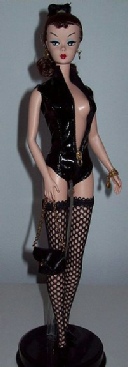

Exploring our past to sort out myth from reality
Share this Page on
Facebook or Twitter

These are the voyages of the TimeShip Anachron.
Our Mission: To boldly explore the past, dispelling
mythinformation and mythconceptions
of American History along the way.
 Visit us on Facebook
Visit us on Facebook
Meet MythAmerica LITE
The Dark Side of Barbie
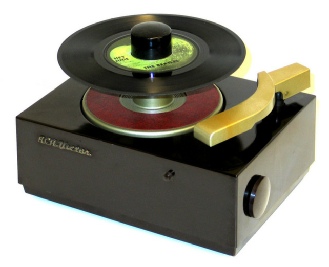
On my birthday in 1959 I turned 13 years old. Far too sophisticated an age to request a doll. I don't remember exactly what presents I got that year, but it was probably mostly clothes and jewelry, along with perhaps a portable record player like this one to play my burgeoning collection of Everly Brothers 45s.
Yes, I was way too old to pay any attention to the New Girl on the Block who debuted at the New York Toy Fair that year and soon dominated the ads on TV. But if I'd been just a couple of years younger, I would no doubt have jumped on the bandwagon to nag my parents that I absolutely had to have my own Barbie, the fascinating new "teen fashion" doll in the zebra-
In my younger years I had owned several plastic "fashion dolls," including one dressed in a royal gown like the Queen of England. But under the glamorous fashions, the dolls' naked plastic bodies did not look like the bodies of the kind of adult women that would have worn such clothes. The bodies were basically "pre-
And then along came Barbie.
How, you may wonder, did the toy industry jump in one giant leap from flat-
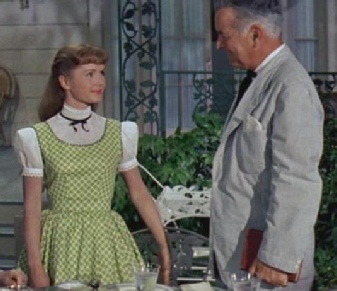
But no. Instead we had a doll who looked much more like Sophia Loren (as in this 1957 pic from the movie The Pride and the Passion, when she also was 25 years old.)
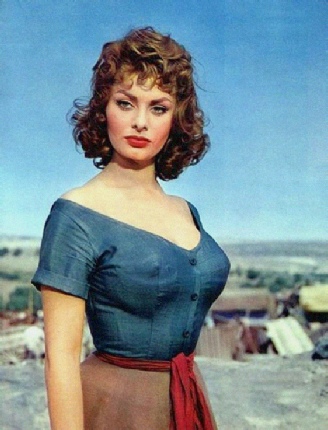
Not just the large bosom and tiny waist either…they managed to capture the sultry face too, with its bright red pouty lips and eyes coyly glancing off to the side rather than right at you as you would expect a doll to do.

Just who at the Mattel Corporation came up with this quirky soft-
The answer to that question takes us back several years before 1959…and far away from America.
Every American who has ever been to a grocery store in the US is familiar with weekly "tabloid papers" like the National Enquirer. You can't go through the check-
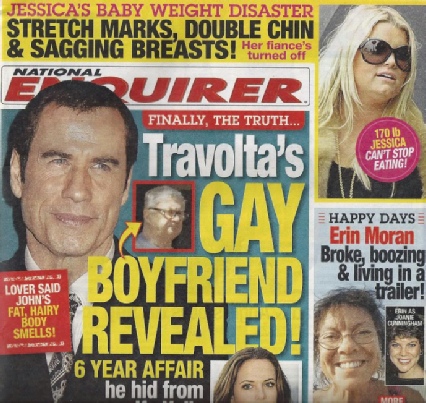
What you may not realize is that tabloids are a world-
Post-
Axel Springer founded Bild in 1952, took lessons from the British [tabloid] Daily Mirror, and watched his readership grow fat on a diet of celebrity-
And it takes a lot of news to bump the front page girl off the front page. When Angela Merkel won the chancellorship from Gerhard Schröder at the end of 2005, the Page One Girl stayed put. [Source]
And don't misunderstand … although the Bild has always featured scantily-

The Bild was risqué right from the beginning. And not just in photos. Early in the first year of publication, Springer wanted some filler material for an issue and requested staff artist Reinhard Beuthien to draw a one-
He drew a cute baby, but his boss didn't like it. So he kept the face, added a ponytail and a curvy woman's body and called his creation "Lilli".
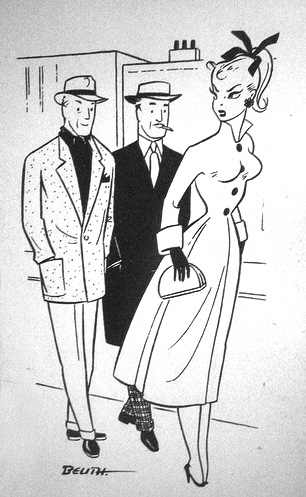
She sat in a fortune-
Lilli was post-
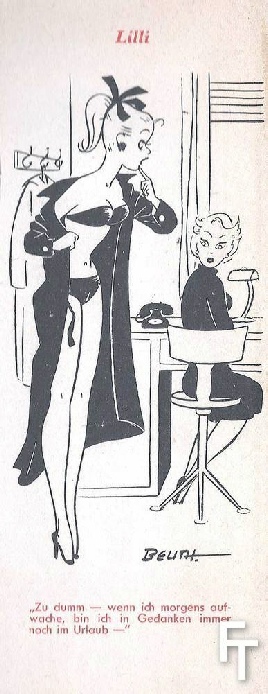
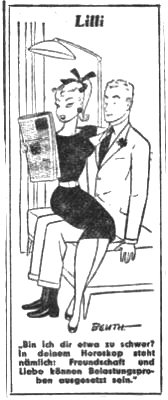
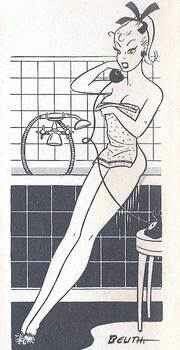
The Lilli cartoons were wildly popular, no doubt particularly with the male readership of Bild. So to capitalize on this popularity, as an advertising gimmick, the Bild management decided to market a 3-

Hitch-
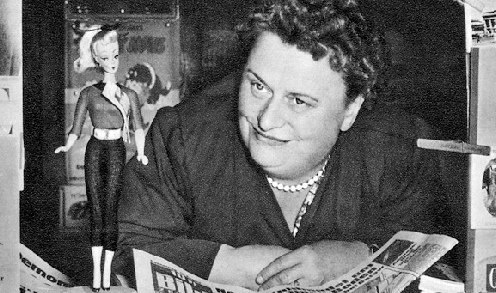
I suppose they'd have been popular gifts or party favors for "stag parties." Some guys no doubt used them as "mascots," such as these smiling pilots.
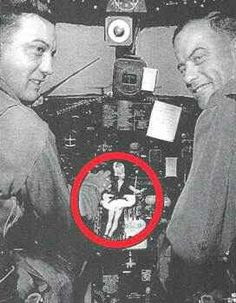
A modern version in the 21st century would be sold, I suppose, in Spencer's Gifts in the malls, next to the other "novelty sex toys." Clothes were not originally sold separately, but she did have a wardrobe that varied…you'd just buy a new doll if you wanted a different outfit, I guess. Like these fairly modest ones.
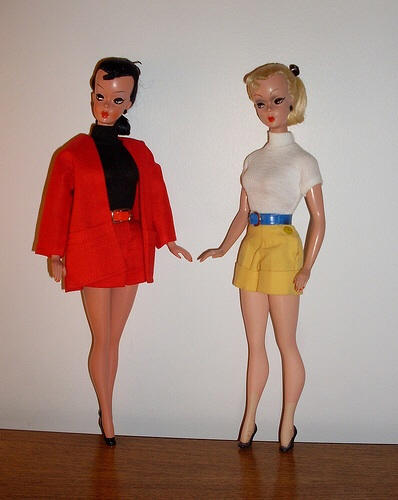
Or these far-
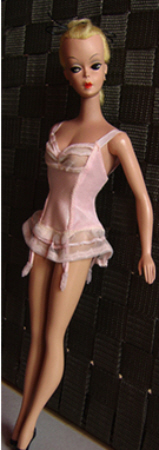
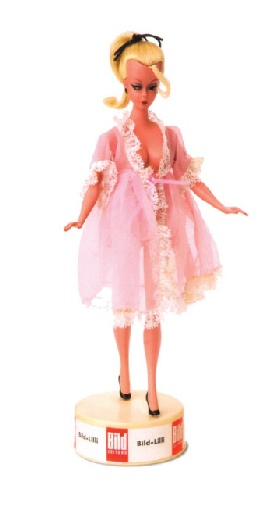
Later young German girls started nagging their parents to get Lilli as an actual "fashion doll" for the playroom, since there was nothing else like her on the market. And thus the toy maker decided to start marketing separate clothing outfits and accessories.
By now I would suppose you are guessing where this story is going. If you are too young to have seen the "original" Barbie, it might not be QUITE so obvious. But if you were around in 1959 to see the very first Mattel super star, here's what you'd remember.
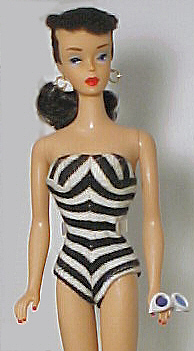
And if you saw the first Lilli in 1955, here is what you would remember.

Uh-
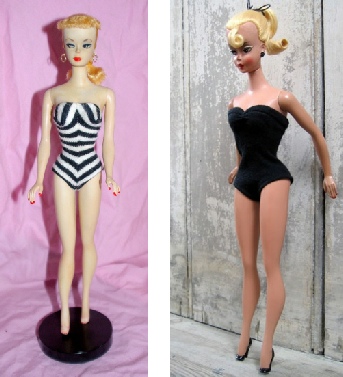
The ads made the connection even clearer.
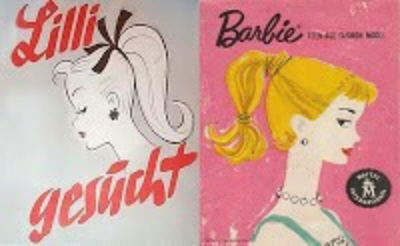
Yes, the most famous All-
Ruth Handler watched her daughter Barbara play with paper dolls, and noticed that she often enjoyed giving them adult roles. At the time, most children's toy dolls were representations of infants. Realizing that there could be a gap in the market, Handler suggested the idea of an adult-
During a trip to Europe in 1956 with her children Barbara and Kenneth, Ruth Handler came across a German toy doll called Bild Lilli. The adult-
…Upon her return to the United States, Handler reworked the design of the doll (with help from engineer Jack Ryan) and the doll was given a new name, Barbie, after Handler's daughter Barbara. The doll made its debut at the American International Toy Fair in New York on March 9, 1959. This date is also used as Barbie's official birthday. [Source]
"Reworked the design" is a bit of an exaggeration. "Made a few tweaks" is more like it!
The body shapes are almost entirely indistinguishable, from the ridiculously tiny feet …
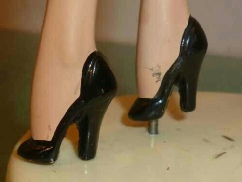
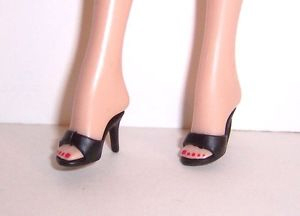
…to the ridiculously narrow waistline and the ridiculously over-
And then there's the skinny giraffe-
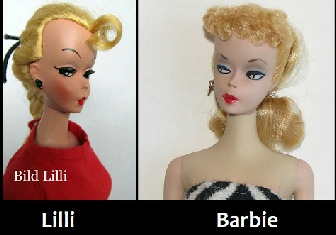
The faces are indeed a bit different…but more "cosmetically" than in the basics. Both have a broad forehead, a tiny chin (remember…the cartoon Lilli started out with the head of a baby, which is where you get such facial proportions), almost identical teensy noses, puckered red lips, arched eyebrows (Barbie's are just "bent" a bit more), and almond-
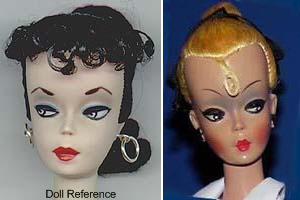
It was clear into the 1970s before Mattel even tweaked the Barbie head mold so that the doll actually looked forward instead of sideways! And relaxed the puckered lips to allow the hint of a smile and show some teeth.
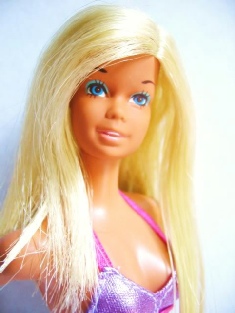
Although some might say that new look started out more of a glazed expression, a creepy "stare right through you" look than an attempt at friendliness for a change!
But at the end of the day, there is no question that Ruth Handler and the toymakers at Mattel ended up with a doll in 1959 that was easily at least a "first cousin" of Bild Lilli. They could have chosen to start from scratch and make a doll that resembled the proportions and look of a real human teenager or young adult woman. Someone recently created just such a fashion doll. Here's what the "Lammily Doll" looks like. [Read more about her on the Lammily website.]
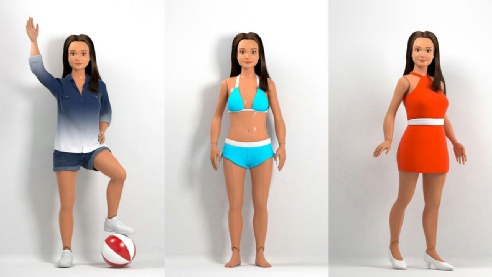
After all, long before 1959 toymakers had bragged about how "lifelike" their baby dolls and toddler dolls were. Why would they not want to make a lifelike older doll, that a child might even be able to look to in a healthy way as a "role model" to emulate? But no, Handler decided to go with the totally unnatural…and hypersexual…Lilli look. With measurements based on nothing more than the sexual fetishes of some men…wasp waist, impossibly tiny feet, exaggerated bosom. And made-
Which got me to thinking. I have a daughter who was born in 1970. Although I held off as long as I could on agreeing to get her a Barbie doll, one of her grandmothers broke the impasse and started her down the Barbie Trail in 1977 with a Superstar Barbie for her birthday.
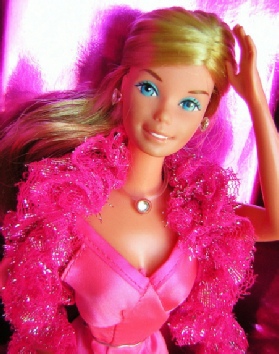
I have to admit at least by then the newest Barbie had a much more friendly and a much less sexual expression than the original 1959 Barbie…and than most of her incarnations for the first decade. She still had the freakishly unnatural body shape, but the smile was a definite improvement!
But what if Mattel decided to revisit Barbie's Roots for her sixtieth anniversary coming up in 2019? They could issue a collectible clone of the Lilli doll that started it all. And call it not "Superstar Barbie," but…
Porn Star Barbie
